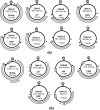Advances in Small Isometric Multicomponent ssDNA Viruses Infecting Plants
- PMID: 23637475
- PMCID: PMC3550773
- DOI: 10.1007/s13337-010-0010-3
Advances in Small Isometric Multicomponent ssDNA Viruses Infecting Plants
Abstract
Multicomponent ssDNA plant viruses were discovered during 1990s. They are associated with bunchy top, yellowing and dwarfing diseases of several economic plants under family Musaceae, Leguminosae and Zingiberaceae. In the current plant virus taxonomy, these viruses are classified under the family Nanoviridae containing two genera, Nanovirus and Babuvirus. The family Nanoviridae was created with five members in 2005 and by 2010, it has expanded with four additional members. The viruses are distributed in the tropical and subtropical regions of Asia, Australia, Europe and Africa. The viruses are not sap or seed transmissible and are naturally transmitted by aphid vector in a persistent manner. The genome is consisted of several circular ssDNAs of about 1 kb each. Up to 12 DNA components have been isolated from the diseased plant. The major viral proteins encoded by these components are replication initiator protein (Rep), coat protein, cell-cycle link protein, movement protein and a nuclear shuttle protein. Each ssDNA contains a single gene and a noncoding region with a stable stem and loop structure. Several Rep encoding components have been reported from each virus, only one of them designated as master Rep has ability to control replication of the other genomic components. Infectivity of the genomic DNAs was demonstrated only for two nanoviruses, Faba bean necrotic yellows virus and Faba bean necrotic stunt virus (FBNSV). A group of eight ssDNA components of FBNSV were necessary for producing disease and biologically active progeny viruses. So far, infectivity of genomic components of Babuvirus has not been demonstrated.
Keywords: ABTV; BBTV; Babuvirus; CBTV; CFDV; FBNSV; FBNYV; MDV; Nanovirus; PNYDV; SCSV; ssDNA virus.
Figures



Similar articles
-
First Report of a Nanovirus Disease of Pea in Germany.Plant Dis. 2010 May;94(5):642. doi: 10.1094/PDIS-94-5-0642C. Plant Dis. 2010. PMID: 30754436
-
[Nanoviruses, small plant viruses: similarities and differences with geminiviruses].Virologie (Montrouge). 2007 Feb 1;11(1):27-42. doi: 10.1684/vir.2011.9629. Virologie (Montrouge). 2007. PMID: 34753255 French.
-
Ten distinct circular ssDNA components, four of which encode putative replication-associated proteins, are associated with the faba bean necrotic yellows virus genome.J Gen Virol. 1998 Dec;79 ( Pt 12):3101-9. doi: 10.1099/0022-1317-79-12-3101. J Gen Virol. 1998. PMID: 9880028
-
Epidemiology and integrated management of persistently transmitted aphid-borne viruses of legume and cereal crops in West Asia and North Africa.Virus Res. 2009 May;141(2):209-18. doi: 10.1016/j.virusres.2008.12.007. Epub 2009 Jan 17. Virus Res. 2009. PMID: 19152820 Review.
-
Nanoviruses: genome organisation and protein function.Vet Microbiol. 2004 Feb 4;98(2):103-9. doi: 10.1016/j.vetmic.2003.10.015. Vet Microbiol. 2004. PMID: 14741122 Review.
Cited by
-
Recent advances in understanding the replication initiator protein of the ssDNA plant viruses of the family Nanoviridae.Virusdisease. 2019 Mar;30(1):22-31. doi: 10.1007/s13337-019-00514-9. Epub 2019 Mar 1. Virusdisease. 2019. PMID: 31143829 Free PMC article.
-
Identifying geographic hot spots of reassortment in a multipartite plant virus.Evol Appl. 2014 May;7(5):569-79. doi: 10.1111/eva.12156. Epub 2014 Apr 9. Evol Appl. 2014. PMID: 24944570 Free PMC article.
-
Insights into the Differential Composition of Stem-Loop Structures of Nanoviruses and Their Impacts.Microbiol Spectr. 2023 Aug 17;11(4):e0479822. doi: 10.1128/spectrum.04798-22. Epub 2023 Jun 27. Microbiol Spectr. 2023. PMID: 37367433 Free PMC article.
-
Non-replicative Integral Membrane Proteins Encoded by Plant Alpha-Like Viruses: Emergence of Diverse Orphan ORFs and Movement Protein Genes.Front Plant Sci. 2017 Oct 27;8:1820. doi: 10.3389/fpls.2017.01820. eCollection 2017. Front Plant Sci. 2017. PMID: 29163564 Free PMC article.
-
Computational studies on rep and capsid proteins of CRESS DNA viruses.Virusdisease. 2024 Mar;35(1):17-26. doi: 10.1007/s13337-024-00858-x. Epub 2024 Feb 29. Virusdisease. 2024. PMID: 38817400 Free PMC article.
References
LinkOut - more resources
Full Text Sources
Miscellaneous
